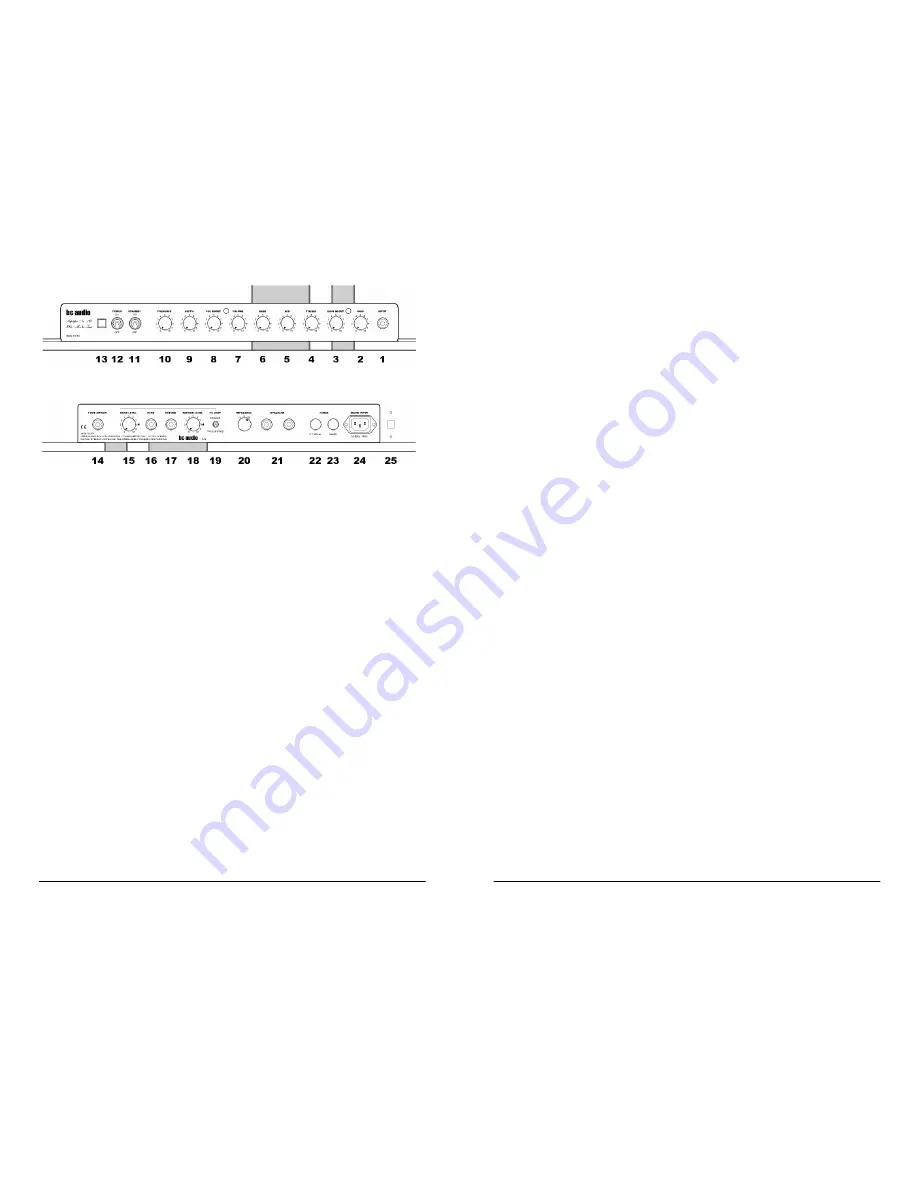
bc audio
9/2014
Amplifier No. 10 Owner’s Manual
Front Panel
Rear Panel
FRONT PANEL
1. Input Jack
Plug a guitar cable into the INPUT jack, and the other end into your guitar, pedal
board or accordion.
2. Gain Control
GAIN determines the amount of gain or amplification applied to the signal, and
thus the amount of distortion. Depending on the strength of your pickups, you will
find that breakup begins when GAIN is on about 5. Increasing GAIN will bring on
more rich, thick and chocolaty distortion.
3. Gain Boost Control and Indicator
GAIN BOOST sets the amount of additional gain when engaged by the included
dual foot switch. Use Gain Boost for solos or high-gain rhythm. When engaged,
the LED indicators on the front panel and on the foot switch will light. If no foot
switch is plugged into the FOOT SWITCH jack (14), the Gain Boost is engaged.
4, 5 & 6. Bass, Mid and Treble Controls
The BASS (6), MID (5) and TREBLE (4) tone-shaping controls are located early
in the preamplifier, to shape the sound of the guitar signal coming in, before any
distortion occurs. PRESENCE (10) and DEPTH (9) (see below) are used to
shape the overall tonal response of the amplifier, including the power section.
7. Volume Control
VOLUME functions as a Master Volume control, setting the overall loudness of
the amplifier. Distortion can be obtained at any volume level by setting GAIN (2)
4
high enough to overdrive the preamp, and setting VOLUME to any desired
volume level. Setting VOLUME very high will send the power section into
overdrive, too. Yummy!
8. Volume Boost Control and Indicator
VOL BOOST sets the amount of increased volume when engaged by the
included dual foot switch. Use Volume Boost for a true increase in volume for
solos. When engaged, the LED indicators on the front panel and on the foot
switch will light. If no foot switch is plugged into the FOOT SWITCH jack (14), the
Volume Boost is engaged.
9 & 10. Presence and Depth Controls
PRESENCE (10) adjusts the amp’s overall brilliance. DEPTH (9) affects the low
frequency response. These two controls works in the amp’s power section to
change the sound and feel of the amp. Lower PRESENCE settings produce a
darker, “browner” sound (yeah, I know), while higher settings produce a brighter,
tone. Higher settings of DEPTH give the amp low-end punch and thump. You
may hear some scratchiness when rotating these controls. This is normal.
11 & 12. Power & Standby Switches
To turn on the amp, move POWER (12) to ON while leaving STANDBY (11) in
the OFF position to allow the tubes to warm up. After a half-minute or so, flip the
STANDBY switch up to the ON position. To turn the amp off, simply flip both
switches down to OFF. There’s no need to put the amp in standby mode when
shutting down.
13. Power Indicator
The Power Indicator lamp will illuminate when power is connected and the
POWER switch (12) is set to ON. If it doesn’t light, the power is not connected, or
the mains fuse (23) has blown.
REAR PANEL
14. Foot Switch Jack
Plug the included dual foot switch into the FOOT SWITCH jack. The foot switch
controls the Gain Boost (3) and Volume Boost (8) functions independently.
15-19. Effects Loop
To connect your pedals or outboard effects to the effects loop, run a standard
shielded instrument cable from the SEND jack (16) to the input of the first
outboard device. Run another instrument cable from the output of the last device
to the RETURN jack (17). Adjust SEND LEVEL (15) and RETURN LEVEL (18)
as needed. For best performance with guitar pedals, set SEND LEVEL to 5-7 and
set RETURN LEVEL to 10.
Use the FX LOOP ENGAGE/TRUE BYPASS switch (19) to engage or bypass
the loop. Signal is always present at the SEND jack, regardless of the position of
this switch.
5























